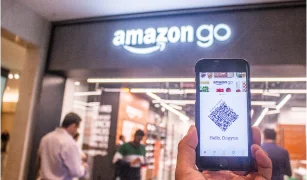Ecommerce is not just booming; it's transforming at an unprecedented pace. Looking ahead, the future of ecommerce promises even more innovation. With personalized shopping experiences and the effortless blending of virtual and physical retail, the next wave of change is ready to redefine the ecommerce landscape.
Ecommerce has become a powerhouse of growth and innovation, providing consumers unparalleled convenience, choice, and access to more products and services. With more people embracing online shopping for its ease, value, and variety, the future of the ecommerce industry looks brighter than ever.
So, let's dive in and discover the captivating developments that await in the ever-expanding world of ecommerce.
What is the Importance of Ecommerce?
Ecommerce services are crucial for modern businesses as they enhance competitiveness, eliminate geographical barriers, and offer numerous advantages for entrepreneurs, startups, and large organizations.
Several factors that demonstrate the importance of ecommerce include:
- Convenience: Ecommerce offers unparalleled convenience, allowing customers to explore and buy products or services from the comfort of their homes anytime. This accessibility factor significantly contributes to its soaring popularity.
- Global Reach: Ecommerce helps businesses to cross geographical boundaries and engage with a global customer base. Companies can reach previously unreachable customers by leveraging on growing ecommerce future trends, while consumers get access to several products and services.
- Cost Efficiency: Ecommerce reduces the overhead expenses associated with maintaining physical storefronts. This cost-saving advantage will result in more competitive customer pricing and higher profit margins for businesses in the future of the ecommerce industry.
- Customization: Ecommerce platforms enhanced by cutting-edge ecommerce web development allow businesses to gather valuable customer data and customize the shopping experience to individual preferences. Companies that provide personalized recommendations and targeted promotions can enrich customer retention and encourage repeat purchases, shaping the ecommerce industry.
- Convenient Purchasing Option: Customers can access an online store any time, every day of the year, regardless of their schedule. People are now looking for online shopping options that allow them to have things and services delivered to their doorsteps without leaving their homes. Customers may purchase goods and services whenever they want, even late at night and early in the morning, which is convenient.
The Future Of Ecommerce: Key Trends to Watch
We’ll explore the key trends transforming online shopping. Discover how businesses are personalizing the shopping experience and evolving customer preferences.

Artificial Intelligence (AI)
AI comprises various technologies, such as machine learning, deep learning, computer vision, and natural language processing. These technologies let machines evaluate data, discover patterns, make decisions, and act without human interaction. According to a Forbes Advisor study, a significant number of respondents (64%) believe AI will enhance consumer relationships and productivity, while 60% expect AI to boost sales growth.
- Implementing AI-powered chatbots and virtual assistants can help improve customer service in the ecommerce industry. These systems can respond instantly to customer inquiries, assist with purchases, and make tailored suggestions. They can operate around the clock, increasing customer engagement and satisfaction.
- AI evaluates customer data to deliver personalized shopping recommendations, marketing messages, and search results. By understanding customer preferences and behavior, ecommerce businesses can present products likely to generate sales, shaping the future of the e-commerce industry.
Augmented Reality (AR)
AR is an exciting ecommerce latest technology that overlays digital information on real-world objects using smartphones or smart glasses. AR provides an opportunity for ecommerce to combine the online and offline worlds, resulting in a more dynamic and satisfying purchase experience.
- AR enables fashion and accessory businesses to virtually try on apparel, spectacles, jewellery, and more. It can be performed through smartphone cameras, which let buyers preview how things will appear on them, minimizing the uncertainty associated with online purchases.
- AR allows customers to visualize furniture and home decor in their environments using smartphones or tablets, placing 3D models in their homes for more informed purchasing decisions.
Social Commerce
Social commerce, leveraging the ecommerce latest technology, integrates social media and e-commerce platforms, enabling users to shop directly within platforms like Facebook, Instagram, and Pinterest. This integration aligns with ecommerce future trends, making discovering, exploring, and purchasing products or services more accessible.
- Maintain an active presence on social media channels where your audience is most engaged. Regularly provide compelling content, such as product features, customer testimonials, and an inside look at the business. This approach supports the future of ecommerce by creating a strong online presence.
- Businesses can share shoppable posts on platforms like Instagram and Facebook, allowing viewers to immediately purchase the items displayed in images or videos. The integration of showing and purchasing may significantly boost sales.
Voice Search
It utilizes speech recognition and NLP algorithms to interpret the user's spoken queries, allowing them to perform various tasks. Voice search has become popular as virtual assistants and smart speakers have emerged, offering people an accessible method to connect with technology.
- Improve website content for voice searches using natural language and a conversational tone. It covers long-tail keywords and queries people will likely ask while using voice searches.
- Incorporate voice recognition technology into ecommerce systems, allowing customers to buy with voice commands. It might be handy for reorganizing products or running quick searches.
Mobile Commerce (m-commerce)
Mobile commerce involves purchasing and selling products and services using mobile devices. It relies primarily on mobile shopping applications, mobile-optimized websites, and mobile payment methods.
- Verify that your ecommerce website is optimized for mobile devices. It involves responsive design, quick loading times, and simple navigation on tiny displays.
- Create an innovative mobile application for your ecommerce business. Mobile apps may improve the user experience, speed up the performance, and enable customers to get push notifications.
Omnichannel Commerce
It integrates online and offline channels, providing a seamless customer experience. It unifies inventory management, customer data, and communication strategies, eliminating barriers between sales and communication channels.
- Ensure that the brand's appearance, tone, messaging, and quality are consistent across all channels, such as online platforms, physical stores, mobile applications, social media, and customer service.
- Provide consistent customer service through all channels. Customers should be able to contact customer support through their chosen channel, whether social media, email, phone, or in-person.
Sustainability
It refers to implementing eco-friendly methods and initiatives throughout the supply chain and operational processes. The goal is to lower the environmental effects of online shopping operations, encourage ethical sourcing, and contribute to a more sustainable and eco-friendly future.
- Choose recyclable, biodegradable, or compostable packaging materials. Decrease packing size to decrease waste, and consider creative packaging options with a lower environmental impact.
- Select products and resources from sustainable and ethical providers. Prioritize suppliers who showcase environmental responsibility and fair labour standards.
Same-day Delivery
Same-day delivery in ecommerce ensures orders are delivered the day they're placed, meeting the demand for immediacy and convenience and providing customers with rapid access to their purchases.
- Develop or collaborate with a logistical infrastructure that can handle quick turnaround times. This might involve investing in or partnering with local distribution hubs and warehouses.
- Implement a sophisticated inventory management system that delivers real-time stock-level information. This ensures that products are ready for immediate dispatch.
Development of Marketplaces
The emergence of online marketplaces emphasizes digital platforms that connect buyers and sellers. This results in virtual hubs where merchants provide diverse products and services, making business more accessible and easy.
- Find and establish a presence in online marketplaces popular among your target demographic. It might include global platforms such as Amazon and eBay and smaller marketplaces.
- Verify that your product listings on these marketplaces are completely optimized. It includes excellent images, informative and SEO-friendly product descriptions, competitive pricing, and well-defined shipping and return processes.
Personalization
Personalization in e-commerce involves tailoring content, recommendations, and interactions to user preferences and behaviors. The primary objectives of personalization are to enhance the customer experience, boost engagement and satisfaction, and increase conversion rates.
- Collect and evaluate information on customer behavior, preferences, and demographics. This information may arise from various sources, including website interactions, purchase history, social media activity, and customer feedback.
- Utilize algorithms and machine learning to make individualized product suggestions. These recommendations may be based on the customer's browsing history, recent purchases, or products frequently bought.
What is the Future of E-commerce Industry
E-commerce has significantly evolved since its inception. With the advent of innovative technologies and changing consumer behavior, the future of the ecommerce industry looks promising. It will continue to transform in the coming years, presenting businesses with creative ways to reach customers. This evolution offers consumers enhanced convenience and access to numerous products and services, shaping the future of ecommerce.
As emerging trends and technologies develop, businesses and customers will play critical roles in determining the future of ecommerce industry. How we purchase online is about to change significantly, owing to AI-powered customized experiences and immersive technologies like AR and VR.
Conclusion
The future of ecommerce industry is bright, and ecommerce development companies are essential partners for organizations looking to flourish in this highly competitive market. By utilizing cutting-edge technology and best practices, ecommerce development companies can assist businesses in reaching more customers, growing revenue, and remaining ahead of the curve in today's fast-changing digital world.
Want to keep ahead of ecommerce trends?
Innoraft’s website consulting can help you change your business tactics to capitalize on these emerging trends and keep your online store competitive.
FAQ
Frequently Asked Questions
Didn’t find what you were looking for here?


